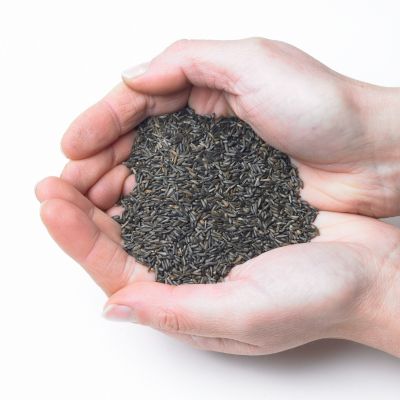Redpoll Factfile
The full name for this species is actually the Lesser Redpoll, as relatively recently (year 2000) it was classified as a separate species from the very similar Common Redpoll (also called the Mealy Redpoll) which, despite the name, is not common in the UK at all. Lesser Redpolls breed in the UK, whereas Common Redpolls are winter visitors only and generally just to the eastern side of the UK. There are subtle differences only between the two species, but since it is the Lesser Redpoll that’s much more likely to be seen in gardens across the UK, then that’s what we’ll focus on here. The diagnostic feature is the red patch on the forehead of both sexes and black bib, then a pale grey-brown body (lighter underside) and wings, with darker brown streaks. Usually there are pale pinky-red patches on the breast in the breeding season on the male bird. They are a small finch and often flock with Siskins – and may visit niger seed feeders together in gardens.
Video footage of Redpolls
Redpoll nesting and breeding habits
The nest is constructed in a in a tree – often a young conifer which provides dense cover – or bush, and is a somewhat untidy cup of fine twigs, grass, and plant stems. It then has a lining of plant down, feathers and hair. There are usually two broods per year, with a clutch size of between four and five eggs. The female incubates the eggs alone, but both parents feed the young.
Redpoll history and population trends
The UK population has gone through rapid decline since the 1970s, and now stands at about 10% of its population in that decade. There is no sound evidence currently available as to why, but studies have focused on the reduction in young forestry plantations (a favoured nesting location). The species is now listed as red status in the UK
Behaviour traits of Redpolls
Lesser Redpolls are a sociable bird and a few pairs – perhaps up to six – will often nest quite close together in a loose colony. Outside of the breeding season they form larger flocks which often include Siskins as well. When feeding on birch and alder seeds, the species has a habit of dangling upside down on fine twigs at the end of branches to extract the tiny seeds.
Redpoll diet and food
In the summer months the diet is primarily insects, with the young fed mainly on caterpillars. For the rest of the year the food is largely small seeds, with birch, alder and conifer seeds making up much of the diet. In gardens, the best food by far to attract the species is niger seed, which they’ll either take from a special niger feeder (which has tiny seed ports) or direct from the ground, a table or ground tray.
What should I feed Redpolls?
We recommend the following product to potentially attract Redpolls to your garden.
Frequently Asked Questions
What is the difference between a Linnet and a Redpoll?
The Linnet is a larger finch than a Redpoll, and although both have a patch of red on their heads and typically a blush of red on their breasts (though both only on the male for Linnet), the Redpoll has a much more streaked appearance overall. The two species are also likely to be seen in different habitats, with Redpolls found in birch woodland and also young conifer plantations, with Linnets favouring heaths, farmland and even open wasteland.
Do Redpolls come to feeders?
Redpolls do sometimes come to feeders, and notably in mixed flocks with Siskins. Niger seed and sunflower hearts are both foods which would potentially attract Redpolls to a garden feeder.
Where do common Redpolls nest?
The Common redpoll, also called the Mealy redpoll, does not nest and breed in the UK but instead is a winter migrant here. The species of Redpoll which nests in the UK is the Lesser redpoll (though often just called Redpoll), with the nest usually being in a young conifer tree or dense bush.
Do Redpolls sing?
Yes Redpolls do sing, though the main tune is a somewhat subtle trill – have a listen to this on the sound clip on this page.
How big are Redpolls?
Redpolls are a very small species of finch and basically the same size as a Siskin. So smaller than other finches such as Chaffinch, Goldfinch and Greenfinch.







